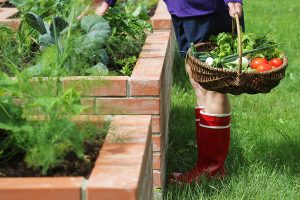 Edible landscaping is a growing trend in Massachusetts, where homeowners are looking to make the most of their outdoor spaces. By integrating edible plants into your landscape, you can enjoy fresh fruits, vegetables, and herbs while also creating a yard that is attractive year-round. When designed thoughtfully, edible landscapes fit seamlessly into New England properties and add beauty, practicality, and sustainability. In this blog, we’ll cover the best practices for integrating edible plants into your Massachusetts landscape and the varieties that thrive in our climate.
Edible landscaping is a growing trend in Massachusetts, where homeowners are looking to make the most of their outdoor spaces. By integrating edible plants into your landscape, you can enjoy fresh fruits, vegetables, and herbs while also creating a yard that is attractive year-round. When designed thoughtfully, edible landscapes fit seamlessly into New England properties and add beauty, practicality, and sustainability. In this blog, we’ll cover the best practices for integrating edible plants into your Massachusetts landscape and the varieties that thrive in our climate.
Why Edible Landscaping Works in Massachusetts
Massachusetts’ distinct four-season climate provides excellent opportunities for edible landscaping. Cool springs and crisp falls are perfect for leafy greens and root vegetables, while warm summers allow fruiting crops like tomatoes and peppers to flourish. Hardy perennials such as apple trees and blueberry bushes also thrive here, providing structure, blossoms, and harvests year after year. By blending these options into your landscape, you can enjoy seasonal variety without sacrificing aesthetics.
Best Practices for Massachusetts Edible Landscapes
Incorporate Fruit Trees and Shrubs
Fruit trees are a natural fit for Massachusetts landscapes. Apple and pear trees are reliable producers in our region, while peach and cherry trees can thrive with the right placement. Shrubs like blueberries, currants, and elderberries not only yield fruit but also provide seasonal interest with flowers and fall color.
Blend Ornamentals with Edibles
Many edibles add beauty as well as function. Herbs such as thyme, lavender, and oregano provide fragrance and texture, while leafy greens like kale or Swiss chard bring striking color to garden beds. Planting these among ornamental perennials helps unify your design.
Use Raised Beds for Vegetables
Massachusetts soils can vary widely, and raised beds offer better control over drainage and fertility. They also extend the growing season by warming more quickly in spring and staying productive into fall. Raised beds can be integrated into patios or side yards for a clean, structured look.
Plan Around the Growing Season
Seasonality is key in New England. Cool-season crops like lettuce, spinach, carrots, and beets do well in spring and fall. Warm-season crops such as tomatoes, peppers, cucumbers, and squash thrive in the summer. Staggering plantings ensures your yard is both productive and visually appealing throughout the year.
At Dolan Landscaping, we design and install custom landscapes tailored to New England conditions. From fruit trees and herb gardens to raised beds and full-property designs, our team can help you create a yard that provides beauty and fresh food all year long. Call us at (508) 799-4556 or contact us here to get started.